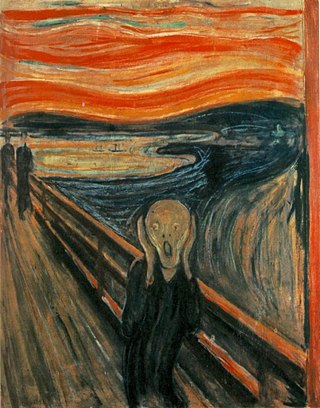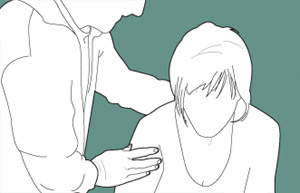Related Research Articles

A phobia is an anxiety disorder, defined by an irrational, unrealistic, persistent and excessive fear of an object or situation. Phobias typically result in a rapid onset of fear and are usually present for more than six months. Those affected go to great lengths to avoid the situation or object, to a degree greater than the actual danger posed. If the object or situation cannot be avoided, they experience significant distress. Other symptoms can include fainting, which may occur in blood or injury phobia, and panic attacks, often found in agoraphobia and emetophobia. Around 75% of those with phobias have multiple phobias.

Anxiety disorders are a cluster of mental disorders characterized by significant and uncontrollable feelings of anxiety and fear such that a person's social, occupational, and personal functions are significantly impaired. Anxiety may cause physical and cognitive symptoms, such as restlessness, irritability, easy fatigue, difficulty concentrating, increased heart rate, chest pain, abdominal pain, and a variety of other symptoms that may vary based on the individual.

Agoraphobia is a mental and behavioral disorder, specifically an anxiety disorder characterized by symptoms of anxiety in situations where the person perceives their environment to be unsafe with no easy way to escape. These situations can include public transit, shopping centers, crowds and queues, or simply being outside their home on their own. Being in these situations may result in a panic attack. Those affected will go to great lengths to avoid these situations. In severe cases, people may become completely unable to leave their homes.

Panic attacks are sudden periods of intense fear and discomfort that may include palpitations, sweating, chest pain or chest discomfort, shortness of breath, trembling, dizziness, numbness, confusion, or a feeling of impending doom or of losing control. Typically, symptoms reach a peak within ten minutes of onset, and last for roughly 30 minutes, but the duration can vary from seconds to hours. Although they can be extremely frightening and distressing, panic attacks themselves are not physically dangerous.
Specific phobia is an anxiety disorder, characterized by an extreme, unreasonable, and irrational fear associated with a specific object, situation, or concept which poses little or no actual danger. Specific phobia can lead to avoidance of the object or situation, persistence of the fear, and significant distress or problems functioning associated with the fear. A phobia can be the fear of anything.

Claustrophobia is a fear of confined spaces. It is triggered by many situations or stimuli, including elevators, especially when crowded to capacity, windowless rooms, and hotel rooms with closed doors and sealed windows. Even bedrooms with a lock on the outside, small cars, and tight-necked clothing can induce a response in those with claustrophobia. It is typically classified as an anxiety disorder, which often results in panic attacks. The onset of claustrophobia has been attributed to many factors, including a reduction in the size of the amygdala, classical conditioning, or a genetic predisposition to fear small spaces.
Phobophobia is a phobia defined as the fear of phobias, or the fear of fear, including intense anxiety and unrealistic and persistent fear of the somatic sensations and the feared phobia ensuing. Phobophobia can also be defined as the fear of phobias or fear of developing a phobia. Phobophobia is related to anxiety disorders and panic attacks directly linked to other types of phobias, such as agoraphobia. When a patient has developed phobophobia, their condition must be diagnosed and treated as part of anxiety disorders.
Blood phobia is an extreme irrational fear of blood, a type of specific phobia. Severe cases of this fear can cause physical reactions that are uncommon in most other fears, specifically vasovagal syncope (fainting). Similar reactions can also occur with trypanophobia and traumatophobia. For this reason, these phobias are categorized as blood-injection-injury phobia by the DSM-IV. Some early texts refer to this category as "blood-injury-illness phobia."
Mental health professionals often distinguish between generalized social phobia and specific social phobia. People with generalized social phobia have great distress in a wide range of social situations. Those with specific social phobia may experience anxiety only in a few situations. The term "specific social phobia" may also refer to specific forms of non-clinical social anxiety.
Social anxiety is the anxiety and fear specifically linked to being in social settings. Some categories of disorders associated with social anxiety include anxiety disorders, mood disorders, autism spectrum disorders, eating disorders, and substance use disorders. Individuals with higher levels of social anxiety often avert their gazes, show fewer facial expressions, and show difficulty with initiating and maintaining a conversation. Social anxiety commonly manifests itself in the teenage years and can be persistent throughout life; however, people who experience problems in their daily functioning for an extended period of time can develop social anxiety disorder. Trait social anxiety, the stable tendency to experience this anxiety, can be distinguished from state anxiety, the momentary response to a particular social stimulus. Half of the individuals with any social fears meet the criteria for social anxiety disorder. Age, culture, and gender impact the severity of this disorder. The function of social anxiety is to increase arousal and attention to social interactions, inhibit unwanted social behavior, and motivate preparation for future social situations.

Nomophobia is a word for the fear of, or anxiety caused by, not having a working mobile phone. It has been considered a symptom or syndrome of problematic digital media use in mental health, the definitions of which are not standardized for technical and genetical reasons.

Thalassophobia is the persistent and intense fear of deep bodies of water, such as the sea, oceans, or lakes. Though very closely related, thalassophobia should not be confused with aquaphobia, which is classified as the fear of water itself. Thalassophobia can include fears of being in deep bodies of water, the vastness of the sea, sea waves, aquatic animals, and great distance from land.
Most people have a fear of medical procedures at some point in their lifetime, which can include the fear of surgery, dental work, doctors, or needles. These fears are seldom diagnosed or treated, as they are often extinguished into adulthood and do not often develop into phobias preventing individuals from seeking medical attention. Formally, medical fear is defined as "any experience that involves medical personnel or procedures involved in the process of evaluating or modifying health status in traditional health care settings."
Scopophobia, scoptophobia, or ophthalmophobia is an anxiety disorder characterized by a morbid fear of being seen in public or stared at by others.

Social anxiety disorder (SAD), also known as social phobia, is an anxiety disorder characterized by sentiments of fear and anxiety in social situations, causing considerable distress and impairing ability to function in at least some aspects of daily life. These fears can be triggered by perceived or actual scrutiny from others. Individuals with social anxiety disorder fear negative evaluations from other people.

Panic disorder is a mental and behavioral disorder, specifically an anxiety disorder characterized by reoccurring unexpected panic attacks. Panic attacks are sudden periods of intense fear that may include palpitations, sweating, shaking, shortness of breath, numbness, or a feeling that something terrible is going to happen. The maximum degree of symptoms occurs within minutes. There may be ongoing worries about having further attacks and avoidance of places where attacks have occurred in the past.

Fear of flying is a fear of being on an airplane, or other flying vehicle, such as a helicopter, while in flight. It is also referred to as flying anxiety, flying phobia, flight phobia, aviophobia, aerophobia, or pteromerhanophobia.
Chronophobia, also known as prison neurosis, is considered an anxiety disorder describing the fear of time and time moving forward, which is commonly seen in prison inmates. Next to prison inmates, chronophobia is also identified in individuals experiencing quarantine due to COVID-19. As time is understood as a specific concept, chronophobia is categorized as a specific phobia.

Hodophobia is an irrational fear, or phobia, of travel.
Ancraophobia, also known as anemophobia, is an extreme fear of wind or drafts. It is rather uncommon, and can be treated. It has many different effects on the human brain. It can cause panic attacks for those who have the fear, and can make people miss out on regular everyday activities such as going outside.
References
- 1 2 Gould, Dr. George Milbry (1910). The Practitioner's Medical Dictionary (2nd ed.). Philadelphia: P. Blackiston's Son & Co. p. 101.
- ↑ "Medical Definition of Fear of oneself". RxList. Retrieved 2023-03-19.
- ↑ "Autophobia (fear of being alone): Definition, symptoms, and treatment". www.medicalnewstoday.com. 2020-08-13. Retrieved 2023-03-19.
- ↑ "Autophobia (Fear of Being Alone): Causes & Treatment". Cleveland Clinic. Retrieved 2023-06-16.
- ↑ Fordham, Beth; Sugavanam, Thavapriya; Edwards, Katherine; Hemming, Karla; Howick, Jeremy; Copsey, Bethan; Lee, Hopin; Kaidesoja, Milla; Kirtley, Shona (February 2021), "Summary tables of included systematic reviews grouped according to the conditions they targeted as per the ICD-11", Cognitive–behavioural therapy for a variety of conditions: an overview of systematic reviews and panoramic meta-analysis, NIHR Journals Library, retrieved 2023-06-16
- ↑ Diagnostic and Statistical Manual of Mental Disorders- Fifth Edition (DSM-5) (5th ed.). American Psychiatric Association. May 18, 2013. p. 198. ISBN 978-88-6030-660-9.
- ↑ "Autophobia (Fear of Being Alone): Causes & Treatment". Cleveland Clinic. Retrieved 2023-03-19.
- ↑ McCray, Alexa; Browne, Allen; Moore, Dorothy (November 9, 1988). "The Semantic Structure of Neo-Classical Compounds". Proc Annu Symp Comput Appl Med Care.: 165–168. PMC 2245192 .
- ↑ Holt, Emily (December 1, 2007). "Me, Myself and I". W Magazine. Archived from the original on December 8, 2015. Retrieved November 30, 2015.
- ↑ Lindsay (2022-05-31). "Fear of Being Alone | What Is Monophobia?". HVRC. Retrieved 2023-07-07.
- 1 2 "Fear of Being Alone". anxietycare.org.uk. Archived from the original on 2006-08-18. Retrieved 2015-12-02.
- ↑ Barber, Chris (2018-11-02). "Loneliness and mental health". British Journal of Mental Health Nursing. 7 (5): 209–214. doi: 10.12968/bjmh.2018.7.5.209 . ISSN 2049-5919. S2CID 149894333.
- ↑ "Autophobia (Fear of Being Alone): Causes & Treatment". Cleveland Clinic. Retrieved 2023-03-28.
- 1 2 3 4 "Autophobia: Fear of Being Alone, Causes, Symptoms & Treatment". www.remediespoint.com. Retrieved 2015-12-07.
- 1 2 "Autophobia or Fear of Being Alone". nobullying.com. Archived from the original on 2015-09-27. Retrieved 2015-12-07.
- ↑ "Fear of Abandonment Phobia – Autophobia". www.fearof.net. 2014-01-26. Retrieved 2015-12-04.
- 1 2 "CTRN: Change That's Right Now | Symptoms". www.changethatsrightnow.com. 12 January 2011. Retrieved 2015-12-04.
- ↑ "Autophobia | Dual Diagnosis". Dual Diagnosis. Retrieved 2015-12-04.
- ↑ "Monophobia - Psychologist Anywhere Anytime". www.psychologistanywhereanytime.com. Retrieved 2015-12-03.
- ↑ "Fear of Abandonment Phobia – Autophobia". www.fearof.net. 2014-01-26. Retrieved 2015-12-03.
- ↑ "Medical Definition of EREMOPHOBIA". www.merriam-webster.com. Retrieved 2015-12-07.
- ↑ Administration, Substance Abuse and Mental Health Services (June 2016). Table 3.11, DSM-IV to DSM-5 Specific Phobia Comparison . Retrieved 14 February 2024.
- ↑ "Autophobia (fear of being alone): Definition, symptoms, and treatment". www.medicalnewstoday.com. 13 August 2020. Retrieved 14 February 2024.
- ↑ "Monophobia Chat room, Anxiety, Panic Attacks, Panic, Forum". www.phobiasupport.com. Archived from the original on 2015-12-08. Retrieved 2015-12-02.
- ↑ Bandelow, Borwin; Michaelis, Sophie; Wedekind, Dirk (30 June 2017). "Treatment of anxiety disorders". Dialogues in Clinical Neuroscience. 19 (2): 93–107. doi:10.31887/DCNS.2017.19.2/bbandelow. PMC 5573566 . PMID 28867934.
- ↑ Chu, Andrew; Wadhwa, Roopma (2024). Selective Serotonin Reuptake Inhibitors. StatPearls Publishing. Retrieved 20 February 2024.
- ↑ Lesser, Ben. "Autophobia | Dual Diagnosis" . Retrieved 2023-06-24.
- ↑ Care, United We (2022-02-25). "A Complete Guide to Overcome Autophobia or Fear of Being Alone". United We Care | A Super App for Mental Wellness. Retrieved 2023-06-24.
- ↑ Barber, Chris (2018-11-02). "Loneliness and mental health". British Journal of Mental Health Nursing. 7 (5): 209–214. doi: 10.12968/bjmh.2018.7.5.209 . ISSN 2049-5919.
- ↑ Lazarus, Herbery (1969). "Psychogenic Hyperventilation and Death Anxiety". Psychosomatics. 10 (1): 14–22. doi: 10.1016/S0033-3182(69)71786-8 . PMID 5780677.
- ↑ "Autophobia :: Chapter 11 - 45 to 51 | Tapastic Comics". tapastic.com. Retrieved 2015-12-02.
- ↑ "deadmau5 feat. Rob Swire - Monophobia (Extended Mix)". YouTube. Retrieved 9 August 2020.
- ↑ "Atithi Devobhava". IMDb .
